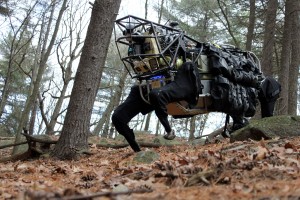Robotic Animals: Man’s New Best Friend?
Some interesting animalistic robots are being perfected by some of the finest minds that the world has to offer, what will their primary applications be?
BigDog is a project started in 2005 by a combination of scientists from NASA and Harvard. It’s application is primarily military, assisting soldiers by carrying large supply loads out in the battlefield. The initial BigDog is actually about as big as a small mule; three feet long by two and a half feet tall. It weighs 240 pounds and can run at four mph while carrying 340 pounds. BigDog runs off of a go-kart engine and is powered by an onboard computer that reacts to an assembly of 50 sensors throughout the unit. The demos were fairly pedestrian, but ugrades have recently been made to traverse on ice, and mount itself when knocked over.
The Legged Squad Support System (LS3) is the next generation of BigDog, the AlphaDog. The LS3 AlphaDog is said to be able to travel “anywhere soldiers and marines go on foot.” That’s a pretty bold statement considering the crazy, choppy, and unpredictable terrain that can be found worldwide. One can imagine a future version os the LS3 that will be able travel by water and air as well. The LS3 is said to be more quiet and nimble than its predecessor, as well as being able to operate in hot, cold, wet and muddy conditions. Improving technology has enabled the LS3 to autonomously follow a human lead, as well as store information gathered through a camera built into it’s head. One can imagine that it will soon feature voice recognition and some other cool features as well.
The Pentagon is getting in on the robo-creature race as well. A four-legged bot called the ‘Cheetah’ recently broke the robotic land speed record, pacing itself at 18 mph. This performance shattered the previous record set in 1989 at MIT by 5 mph. The bodily motions of the robot stunningly mimics those of real animals. Not only are the joints flexible, the robotic cheetah actually flexes and unflexes it’s ‘back’ to increase it’s stride and therefore it’s speed. The fastest human in the world, Usain Bolt, has been clocked at 28 mph, so despite the improvments, robots still have a ways to go. Imagine combining the speed capabilities of the Cheetah with the strength and agility of the LS3, that would make for a pretty indestructible helper.
In the military, a smart and nimble bot like this could retrieve wounded soldiers and hostages alike, saving countless lives. A similar scenario could include search and rescue, and perhaps tracking down missing persons or fugitives using facial recognition technology. One could see a future where this technology is perfected, and used to send a bot like this to explore the Moon, Mars, and beyond. It’s ability to learn and adjust on the fly, while moving quickly and relaying a lot of information, would be invaluable.
These are just a few of the animalbots the world will soon have at it’s disposal. When and how will this technology leak into the commercial realm? Only time will tell. What other game-changing uses can you see a smart, animal-like robot having?
Comments
Tags: Alpha Dog, Big Dog, Harvard, LS3, MIT, NASA, robotic animals
Trackback from your site.



Comments (2)
CrookbythaBOOK
| #
I could see where a robotic seeing eye dog that doesn’t make mistakes due to natural instintcs would be a practical and valuable use of an animal like robot. Or a robotic fly being used for surveillance and espionage purposes could also be a very useful tool for the military, but that might require technology that is still a few years down the road. Keep it coming Bottleawada.
Reply
Observer
| #
This could be helpful to elderly people living in places that do not allow pets, also, a potential money saver on dog food.
Reply